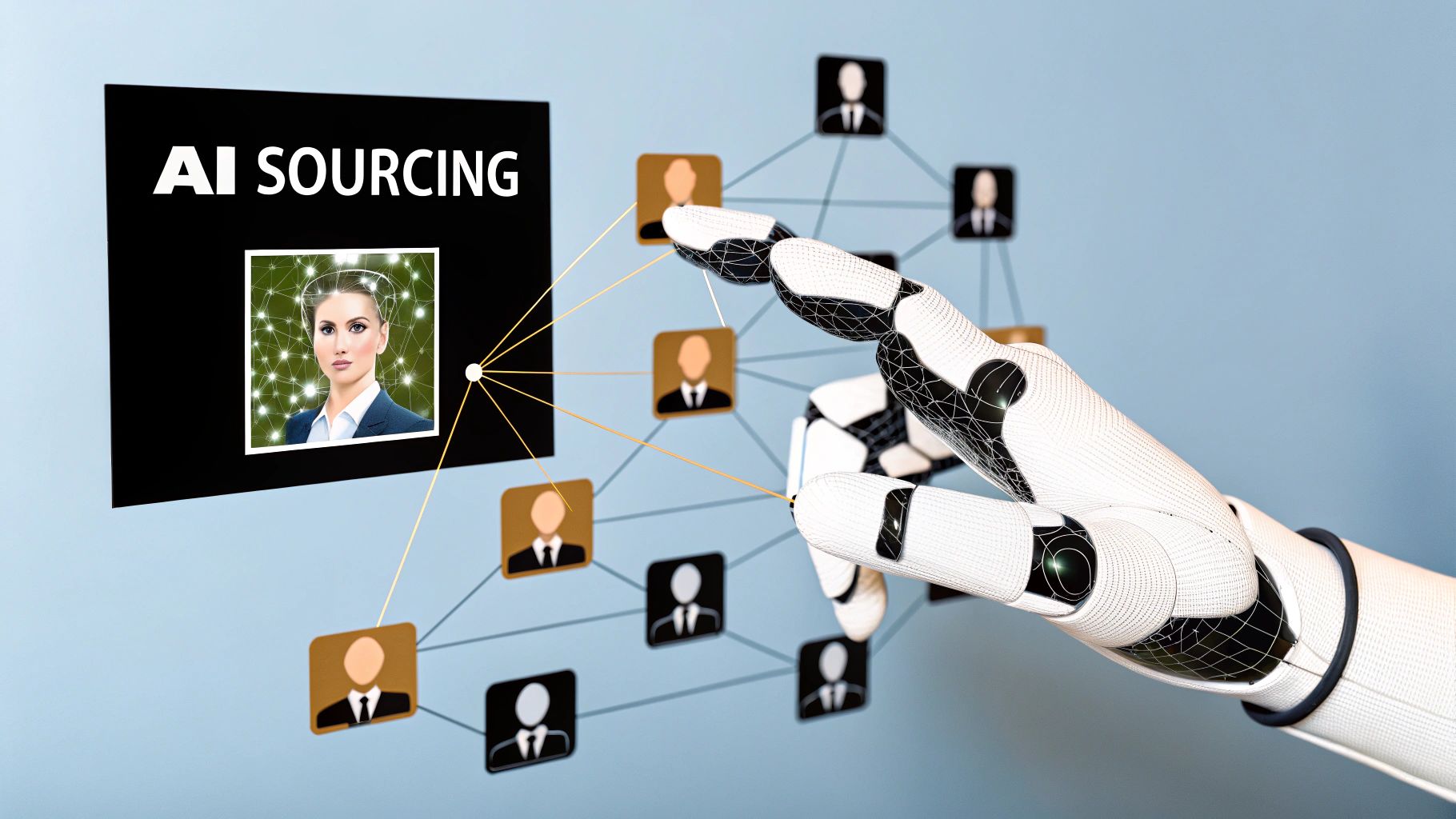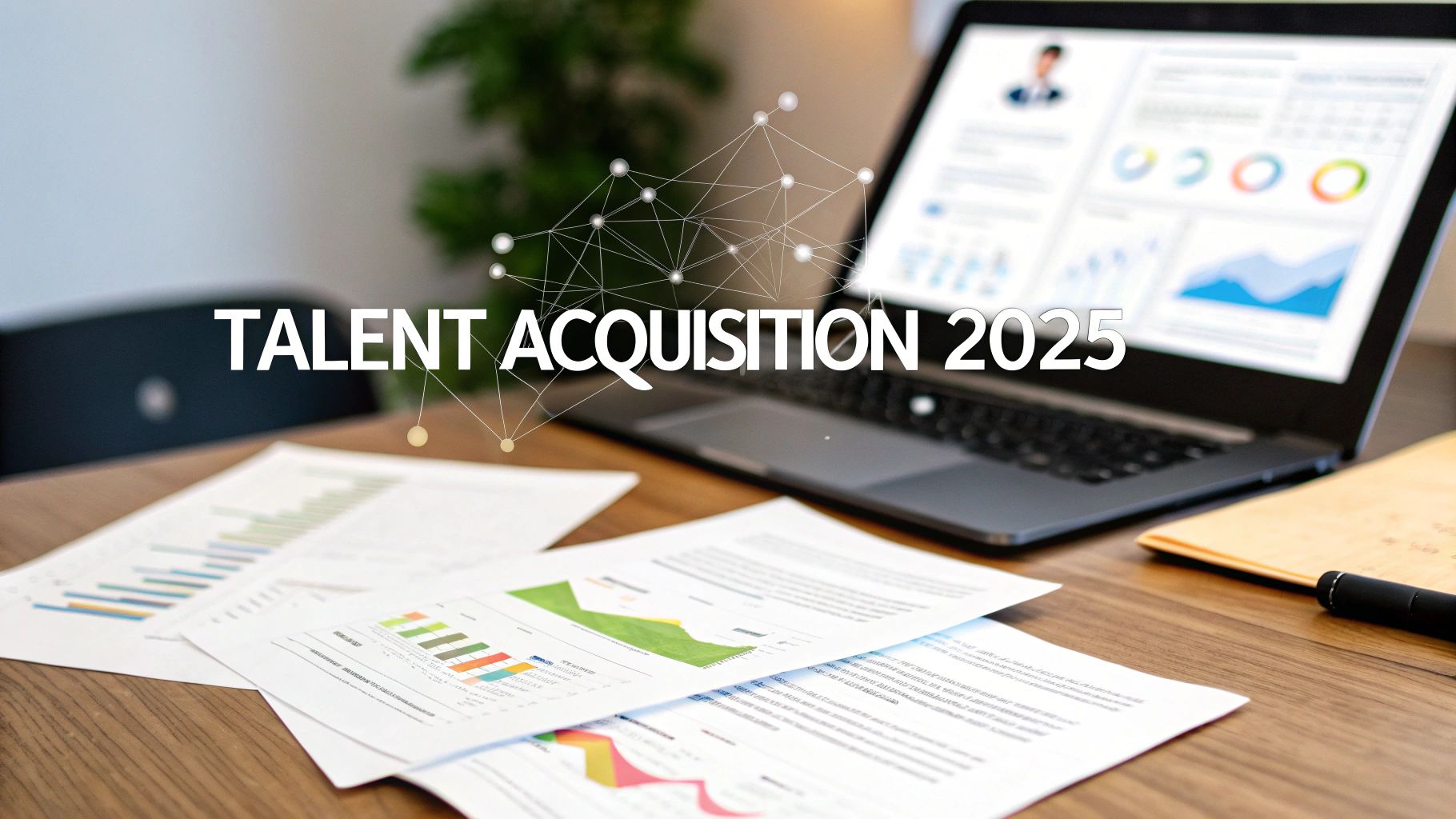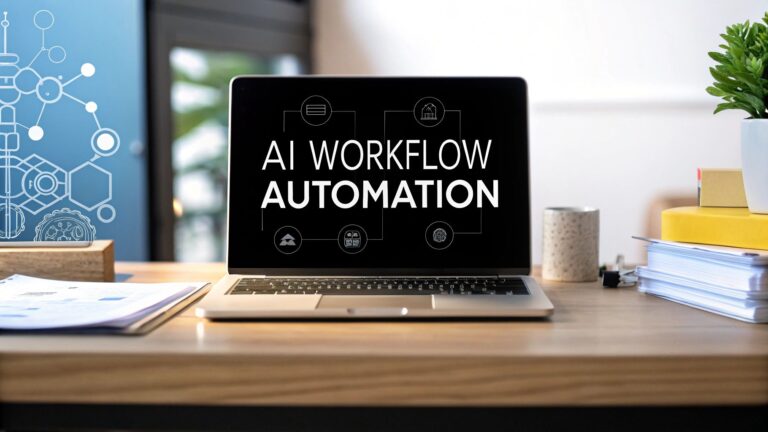9 Talent Acquisition Best Practices for 2025
In the competitive landscape of modern business, attracting and retaining top-tier talent is no longer a simple game of posting a job and waiting for applicants. The modern workforce demands more: authentic employer brands, seamless application experiences, and clear evidence of a forward-thinking culture. Sticking to outdated recruitment methods often leads to missed opportunities, prolonged vacancies, and costly mis-hires that can stifle growth.
To build a resilient and high-performing organization, you must adopt a strategic, multi-faceted approach. This guide provides a comprehensive roadmap, detailing the most impactful talent acquisition best practices that leading companies are using to gain a decisive edge. We will move beyond theory and provide actionable frameworks you can implement immediately.
From harnessing the power of data analytics to embedding diversity, equity, and inclusion at the core of your strategy, these insights will equip you to not just fill roles, but to build the team that will drive your future success. We'll explore how to:
- Develop a proactive and continuous talent pipeline.
- Implement structured, bias-resistant interview processes.
- Leverage AI and automation to streamline sourcing and screening.
- Focus on skills-based hiring to uncover hidden talent pools.
- Foster powerful partnerships between recruiters and hiring managers.
This article is your blueprint for transforming your recruitment function from a reactive necessity into a strategic driver of organizational excellence. Let's dive into the practices that define modern talent acquisition.
1. Employer Branding and Candidate Experience Optimization
Long before a candidate applies for a role, they form an impression of your organization. This perception, known as your employer brand, is the foundation of modern talent acquisition best practices. It's the story you tell about your company's culture, values, and what it’s genuinely like to work there. A strong employer brand acts as a magnet for top talent, attracting candidates who are already aligned with your mission and work style.

This practice extends beyond simple marketing to encompass the entire candidate experience, ensuring every interaction from application to offer (or rejection) is respectful, consistent, and positive. Organizations like Google, known for showcasing innovation and employee perks, and Salesforce, which highlights its commitment to philanthropy, have mastered this. They don't just advertise jobs; they market a compelling employee value proposition (EVP) that resonates with their ideal candidates. A transparent culture deck, like the one famously used by Netflix, can powerfully set expectations and attract individuals who will thrive in your specific environment.
Actionable Implementation Tips
To elevate your employer brand and candidate experience, focus on authenticity and consistency.
- Map the Candidate Journey: Create a detailed map of every touchpoint a candidate has with your company, from discovering the job post to their final interview. Identify friction points, such as a lengthy application form or slow communication, and implement improvements.
- Gather Internal Insights: Survey your current employees to understand what they value most about working for you. Use their authentic feedback to build the core pillars of your EVP and create genuine content, like employee testimonial videos.
- Prioritize Communication: Implement a communication protocol that ensures every applicant receives a timely and personalized response, even if they are not moving forward. Use applicant tracking system (ATS) automation to send initial acknowledgements but add a personal touch for later-stage communications.
- Leverage Social Proof: Actively manage your presence on platforms like Glassdoor and LinkedIn. Encourage current employees to share their experiences and respond professionally to all reviews, both positive and negative.
By integrating these strategies, you create a seamless and attractive hiring process that not only fills current roles but also builds a pipeline of future talent.
2. Data-Driven Recruitment Analytics
Gut feelings and intuition no longer suffice in a competitive hiring landscape. Shifting to a data-driven recruitment model is a cornerstone of modern talent acquisition best practices, transforming hiring from an art into a science. This approach involves systematically collecting and analyzing data across the entire hiring funnel to make informed, evidence-based decisions that enhance efficiency, improve candidate quality, and predict hiring success.

Pioneered by organizations like Google's People Analytics team, this methodology uses key metrics to optimize every stage of the process. For example, Unilever revamped its recruitment by implementing a digital-first, data-heavy process that tracks everything from initial game-based assessments to final interviews, significantly reducing time-to-hire. Similarly, Microsoft leverages powerful LinkedIn Talent Insights to pinpoint which sourcing channels deliver the highest-quality candidates for specific roles, allowing them to allocate resources more effectively and refine their outreach strategies for maximum impact.
Actionable Implementation Tips
To effectively integrate data into your recruitment strategy, start small and build momentum.
- Establish Key Metrics: Begin by tracking 3-5 critical metrics that align with your primary goals, such as Time-to-Fill, Cost-per-Hire, Source-of-Hire, and Quality-of-Hire. As you mature, you can incorporate more nuanced analytics.
- Ensure Data Integrity: Your insights are only as good as your data. Conduct regular audits of your Applicant Tracking System (ATS) and other data sources to correct inaccuracies and ensure consistent data entry protocols are followed by the entire team.
- Create Reporting Rhythms: Schedule regular meetings with hiring managers to review recruitment dashboards and reports. Use this time to collaboratively analyze trends, identify bottlenecks, and adjust strategies based on shared data-driven insights.
- Tell a Story with Data: Instead of just presenting raw numbers, use data visualization tools to create compelling narratives. Show how a high number of applicants from one source led to a successful hire, or how a slow interview stage is impacting your overall time-to-fill.
- Benchmark Your Performance: Compare your key metrics against industry benchmarks and your own historical performance. This provides crucial context and helps you set realistic, ambitious goals for continuous improvement.
3. Proactive Talent Pipeline Development
Reactive hiring, where recruitment only begins when a role opens, is often inefficient and stressful. Proactive talent pipeline development shifts this paradigm from a reactive scramble to a strategic, long-term approach. It involves building and nurturing relationships with potential candidates before an immediate hiring need arises, creating a ready pool of qualified individuals who are already familiar with and engaged by your organization.

This method transforms talent acquisition into a continuous cycle of engagement rather than a series of one-off transactions. Top professional services firms like Deloitte and McKinsey have perfected this, building relationships with university students that last for years, long before graduation. Similarly, Amazon's technical recruiting teams are known for maintaining "warm" lists of top-tier engineers, engaging them with relevant content and opportunities. Salesforce's Trailblazer community is another powerful example, acting as a vibrant ecosystem that doubles as a rich talent pipeline for developers and administrators. This strategy is one of the most effective talent acquisition best practices for reducing time-to-hire and improving quality of hire.
Actionable Implementation Tips
To build a robust and sustainable talent pipeline, focus on providing value and maintaining authentic connections.
- Use CRM-Style Tools: Implement a Candidate Relationship Management (CRM) system or leverage your ATS's CRM features. Use it to track interactions, segment candidates by skill set and interest level, and schedule follow-ups.
- Provide Value First: Don't just reach out when you have a job. Share valuable industry insights, company news, or helpful career advice. This positions your recruiters as trusted advisors rather than just gatekeepers.
- Create Engaging Content and Events: Host webinars, publish insightful blog posts, or create exclusive virtual events for your talent community. This keeps potential candidates engaged and reinforces your employer brand.
- Align with Workforce Planning: Collaborate closely with department heads to understand future hiring needs. This ensures your pipelining efforts are focused on the critical roles you will need to fill in the next 6-18 months.
4. Structured Interview Processes and Behavioral Assessment
To move beyond gut feelings and subjective evaluations, one of the most critical talent acquisition best practices is implementing a structured interview process. This method involves asking all candidates for a specific role the same set of predetermined, competency-based questions in the same order. It focuses on using behavioral and situational questions to objectively assess skills, experience, and potential, ensuring every individual is evaluated against a consistent, fair standard.

The core principle, popularized by industrial psychology research and refined by companies like Google and Amazon, is that past behavior is the best predictor of future performance. Amazon, for example, famously structures its interviews around its 14 Leadership Principles, asking candidates for specific examples of how they have demonstrated these principles in their past work. Similarly, Google's People Operations team uses consistent rubrics and trained interviewers to score candidate responses, drastically reducing hiring bias and improving the quality of hires. This systematic approach ensures that decisions are based on data and evidence, not unconscious bias.
Actionable Implementation Tips
To effectively integrate structured interviewing, focus on standardization and objective evaluation.
- Develop Competency-Based Question Banks: Identify the core competencies required for success in a role (e.g., problem-solving, collaboration, technical proficiency). Create a bank of behavioral questions for each competency, such as "Tell me about a time you had to persuade a stakeholder who disagreed with you."
- Train All Interviewers: Conduct mandatory training for everyone involved in the hiring process. This training should cover structured interview techniques, unconscious bias awareness, active listening, and how to use a standardized scoring rubric.
- Use Panel Interviews: Involve multiple trained interviewers in the process. This allows for diverse perspectives and a more balanced assessment, as each panelist can score the candidate's responses independently before calibrating as a group.
- Document Evidence, Not Opinions: Instruct interviewers to take detailed notes, capturing specific examples and evidence from the candidate's answers using frameworks like the STAR method (Situation, Task, Action, Result). This documentation becomes the basis for a data-driven hiring decision.
By adopting a structured framework, you create a more equitable, defensible, and effective hiring process that consistently identifies the best talent for your organization.
5. Diversity, Equity, and Inclusion (DEI) Integration
True talent acquisition excellence in the modern era is inseparable from a deep commitment to Diversity, Equity, and Inclusion (DEI). This practice involves systematically embedding DEI principles into every stage of the hiring funnel, moving beyond compliance to actively build a workforce that reflects a wide range of backgrounds, experiences, and perspectives. It's about dismantling systemic barriers that may exist in job descriptions, sourcing channels, interview panels, and evaluation criteria to ensure every candidate has an equitable opportunity.
Companies that lead in this area treat DEI not as a separate initiative but as a core business strategy. For instance, Salesforce champions its equality initiatives through transparent reporting and regular pay audits to ensure fairness. Similarly, Intel's landmark $300 million diversity initiative demonstrated a powerful commitment to achieving full representation in its workforce. These organizations understand that diverse teams drive innovation, improve decision-making, and enhance financial performance. Integrating DEI into talent acquisition requires implementing effective diversity hiring strategies to build a truly inclusive workforce.
Actionable Implementation Tips
To genuinely integrate DEI into your talent acquisition process, you must be intentional and proactive.
- Audit Job Descriptions for Bias: Use inclusive language tools to analyze your job postings. Remove gender-coded words, unnecessary jargon, and inflated requirements that may discourage qualified candidates from underrepresented groups from applying.
- Diversify Sourcing Channels: Actively partner with organizations and professional networks that support diverse talent, such as Historically Black Colleges and Universities (HBCUs), women-in-tech groups, and associations for professionals with disabilities.
- Implement Bias Interruption Training: Mandate training for all hiring managers and interviewers to recognize and mitigate unconscious bias. Introduce structured interviews with standardized questions and scoring rubrics to ensure all candidates are evaluated on the same objective criteria.
- Set and Track DEI Goals: Establish clear, measurable diversity goals for your hiring process. Regularly track metrics related to the diversity of your applicant pool, interview slate, and final hires to identify areas for improvement and ensure accountability.
6. Technology Integration and AI-Powered Sourcing
In the modern hiring landscape, speed and precision are paramount. Technology integration, particularly the use of artificial intelligence (AI) and automation, is a cornerstone of effective talent acquisition best practices. These tools move beyond simple applicant tracking to proactively identify, engage, and screen candidates, dramatically increasing efficiency and expanding the talent pool beyond active job seekers. AI-powered sourcing can scan millions of profiles across diverse platforms to find passive candidates with the exact skills and experience required.
This approach transforms recruitment from a reactive to a proactive function. For example, Unilever famously implemented an end-to-end digital recruitment process, using AI to screen resumes and conduct initial video interviews, allowing recruiters to focus on high-value interactions with the most qualified candidates. Similarly, platforms like LinkedIn Recruiter offer advanced search filters and automation that help teams pinpoint and connect with top talent more effectively. When considering the future of recruitment, it's also crucial to understand the implications of AI on job displacement and the evolving workforce. Embracing this technology isn't about replacing recruiters; it's about augmenting their capabilities.
Actionable Implementation Tips
To effectively integrate technology and AI into your sourcing strategy, start small and scale intelligently.
- Audit and Prioritize Needs: Identify the most time-consuming parts of your current process, such as resume screening or initial candidate outreach. Start by implementing a single tool, like an AI-powered resume parser or a chatbot for FAQs, to address a specific pain point.
- Maintain Human Oversight: While AI is powerful, it's not infallible. Always ensure a human recruiter makes the final hiring decision. Regularly audit your AI tools for potential bias to ensure fair and equitable screening, and use technology to inform, not dictate, your choices.
- Train Your Recruitment Team: Technology is only as effective as the people using it. Provide comprehensive training to your recruiters on the new tools' capabilities, best practices, and limitations. This ensures you maximize your return on investment and integrate the tech seamlessly into your workflow.
- Measure Impact and Satisfaction: Track key metrics like time-to-fill, cost-per-hire, and candidate satisfaction before and after implementation. Use this data to prove ROI and make informed decisions about expanding your tech stack. If you're looking to delve deeper into this area, you can learn more about AI in business on makeautomation.co.
By strategically adopting AI and automation, you empower your team to focus on building relationships and making strategic hires, giving you a significant competitive advantage.
7. Skills-Based Hiring and Competency Focus
A transformative shift in talent acquisition best practices involves moving away from a rigid focus on traditional credentials, like degrees and years of experience, to prioritizing a candidate's actual skills and competencies. This skills-based hiring approach evaluates what an individual can do rather than where they learned it. It opens the door to a more diverse and often overlooked talent pool by emphasizing practical abilities, problem-solving skills, and a candidate's potential to succeed and grow within the role.
This methodology has been championed by forward-thinking organizations seeking to address skills gaps and find untapped talent. IBM, for example, pioneered the concept of "new collar" jobs, focusing on filling roles with candidates who have relevant technical skills, regardless of their educational background. Similarly, Google has famously dropped degree requirements for many of its positions, instead using robust work-sample tests and structured interviews to assess critical thinking and practical coding skills. This focus on demonstrable competence over pedigree allows companies to hire more resilient, adaptable, and capable teams.
Actionable Implementation Tips
To effectively implement a skills-based hiring model, your organization needs to redefine how it assesses talent.
- Conduct a Thorough Job Analysis: Before posting a job, collaborate with department heads to deconstruct the role and identify the core competencies and skills truly essential for success. Distinguish between "must-have" abilities and "nice-to-have" qualifications.
- Develop Practical Assessments: Create skills assessments, work-sample tests, or case studies that mirror the actual tasks the employee will perform. For a marketing role, this could be creating a sample campaign brief; for a developer, it might be a small coding challenge.
- Train Hiring Managers: Equip your interviewers with the tools and training to evaluate candidates based on a competency framework rather than relying on resume-based proxies for skill. This includes using structured, behavioral interview questions focused on past performance and problem-solving approaches.
- Partner with Non-Traditional Talent Sources: Expand your sourcing strategy beyond universities to include coding bootcamps, vocational schools, and online certification programs. These platforms are rich with skilled individuals who have proven their capabilities through hands-on learning.
By adopting a skills-first mindset, you not only widen your talent pool but also build a more equitable and effective hiring process that directly correlates to on-the-job performance.
8. Strategic Hiring Manager Partnership
The dynamic between talent acquisition and hiring managers is a critical, yet often underdeveloped, aspect of the recruitment process. Shifting this relationship from a transactional, order-taking model to a strategic partnership is one of the most impactful talent acquisition best practices. This approach positions the TA professional as a consultative advisor who deeply understands business objectives, provides critical market intelligence, and co-creates hiring strategies that drive long-term organizational success.
Instead of simply receiving a job description and sourcing candidates, a strategic TA partner collaborates with hiring managers from the very beginning. This mirrors the consultative model used by top executive search firms like Korn Ferry, which work closely with C-level clients to align talent needs with business goals. Internally, this is exemplified by the HR Business Partner model, popularized by Dave Ulrich, where talent professionals are embedded within business units. This deep integration allows them to challenge unrealistic expectations with data, advise on role design, and contribute to workforce planning, ensuring hires not only fill a seat but also accelerate team and company objectives.
Actionable Implementation Tips
To cultivate a true partnership with hiring managers, focus on building trust, demonstrating value, and fostering collaboration.
- Schedule Strategic Business Reviews: Move beyond discussing individual roles. Hold regular, forward-looking meetings with hiring managers to discuss their team's future needs, potential skill gaps, and upcoming business projects.
- Provide Proactive Market Intelligence: Don't wait to be asked. Regularly share data on compensation trends, competitor hiring activity, and the availability of specific talent pools. This positions you as an expert and helps set realistic expectations for the search.
- Collaborate on Job Descriptions and Scorecards: Co-develop the job description and interview scorecard with the hiring manager. This ensures alignment on the essential skills and competencies from the start and creates a shared standard for evaluation.
- Establish a Service Level Agreement (SLA): Collaboratively define expectations for communication, feedback timelines, and key performance metrics. An SLA clarifies responsibilities for both parties and fosters mutual accountability, which directly contributes to overall team productivity. You can learn more about increasing team productivity on makeautomation.co.
By investing in these partnerships, you transform recruitment from a reactive service into a proactive, strategic function that delivers superior talent and measurable business impact.
9. Continuous Improvement and Agile Recruitment Practices
The world of talent acquisition is not static; it's a dynamic environment where market conditions, candidate expectations, and business priorities can shift overnight. Borrowing principles from software development and lean manufacturing, agile recruitment treats the hiring process as an iterative cycle of planning, executing, and learning. This approach moves away from rigid, long-term plans toward a more flexible framework that can adapt in real-time.
This methodology champions continuous improvement by breaking down the recruitment lifecycle into small, manageable "sprints." Instead of waiting until a hiring cycle is over to assess what went wrong, teams regularly review performance and make immediate adjustments. For instance, if a specific sourcing channel isn't delivering quality candidates after two weeks, an agile team pivots its strategy immediately rather than waiting months. Companies like Spotify have successfully applied agile principles to their internal processes, fostering collaboration and responsiveness within their talent teams. This practice ensures your talent acquisition strategies remain effective and aligned with evolving business needs.
Actionable Implementation Tips
To infuse agile principles into your hiring, focus on creating feedback loops and empowering your team to experiment.
- Implement Team Retrospectives: Hold regular, structured meetings (e.g., bi-weekly) with the recruitment team and hiring managers. Discuss what’s working, what isn’t, and what can be improved for the next "sprint." This is a core component of many business process improvement methods.
- Run Hypothesis-Driven Experiments: Treat changes as experiments. For example, form a hypothesis like, "If we shorten our initial application form to three questions, we will increase qualified applicant volume by 15% without reducing quality." Set clear metrics, test it on a specific role, and measure the outcome.
- Establish Feedback Mechanisms: Create simple, accessible ways for candidates, new hires, and hiring managers to provide feedback on the process. Use this data to identify pain points and areas for iterative refinement.
- Start with Pilot Programs: Don't overhaul your entire process at once. Select one department or a few specific roles to pilot your new agile recruitment practices. Document learnings and demonstrate success before a wider rollout.
By adopting this mindset, you transform talent acquisition from a rigid function into a strategic, data-informed engine for growth.
Talent Acquisition Best Practices Comparison
| Approach | Implementation Complexity | Resource Requirements | Expected Outcomes | Ideal Use Cases | Key Advantages |
|---|---|---|---|---|---|
| Employer Branding and Candidate Experience | High (content & culture alignment) | Significant investment in content, leadership buy-in | Attracts quality candidates; improves reputation | Companies seeking cultural alignment | Enhances offer acceptance; positive candidate impressions |
| Data-Driven Recruitment Analytics | Moderate to High (tools & expertise) | Investment in analytics tools, data quality management | Optimized processes; data-backed decisions | Organizations needing recruitment optimization | Enables continuous improvement; objective decisions |
| Proactive Talent Pipeline Development | High (continuous, long-term effort) | Dedicated resources for sourcing & relationship management | Reduced time-to-hire; access to passive candidates | Firms with recurring or critical hiring needs | Builds ready candidate pools; competitive talent advantage |
| Structured Interview & Behavioral Assessment | Moderate (training & standardization) | Time for interviewer training and process development | Improved candidate performance prediction; fairness | Roles requiring objective candidate evaluation | Reduces bias; legally defensible; consistent evaluations |
| Diversity, Equity, and Inclusion (DEI) | High (culture & process changes) | Ongoing investment in training, tools, and measurement | More diverse, innovative teams; improved employer brand | Organizations aiming for inclusive hiring | Expands talent pool; reduces bias; enhances reputation |
| Technology Integration and AI-Powered Sourcing | High (tech adoption & management) | High initial investment; ongoing optimization | Faster screening; scalable sourcing; improved matching | Large-scale recruiting operations | Increased efficiency; 24/7 candidate engagement; automation |
| Skills-Based Hiring and Competency Focus | Moderate to High (assessment design) | Sophisticated assessments and training | Access to broader talent; better job performance prediction | Companies valuing skills over credentials | Expands talent pool; reduces educational bias; supports mobility |
| Strategic Hiring Manager Partnership | Moderate to High (relationship building) | Time for ongoing collaboration and market research | Better aligned hiring; faster decisions; higher quality hires | Businesses seeking deep recruiter-manager alignment | Stronger stakeholder trust; realistic job expectations |
| Continuous Improvement & Agile Recruitment | Moderate (cultural and process shifts) | Time and dedication for experimentation and feedback loops | Rapid adaptation; ongoing recruitment optimization | Dynamic markets requiring flexibility | Promotes innovation; improves responsiveness; team engagement |
Transforming Recruitment into a Strategic Advantage
Navigating the modern talent landscape requires a fundamental shift in perspective. The journey from a reactive, transactional hiring process to a strategic, proactive talent acquisition engine is no longer a luxury but a core business necessity. The nine best practices we have explored are not just individual tactics to be checked off a list; they are interconnected pillars that support a holistic, resilient, and highly effective recruitment ecosystem. From cultivating an authentic employer brand and ensuring an exceptional candidate experience, to grounding your decisions in robust data analytics, each element builds upon the others to create a powerful, self-reinforcing cycle of improvement.
The era of passive recruitment is definitively over. Building a proactive talent pipeline ensures you are never starting from scratch when a critical role opens up. This foresight, combined with structured interviews and a focus on skills-based hiring, systematically reduces bias and increases the likelihood of identifying candidates who will truly thrive within your organization. Crucially, embedding DEI principles into every stage is not just an ethical imperative but a strategic advantage that unlocks innovation and broader market appeal.
Synthesizing Strategy with Technology
The true catalyst for modernizing these efforts lies in the intelligent integration of technology. Leveraging AI for sourcing, automating repetitive screening tasks, and using analytics platforms to track KPIs are no longer futuristic concepts. They are the practical tools that empower talent teams to operate at a higher, more strategic level. By automating the administrative burden, you free up your recruiters to focus on the distinctly human elements of their work: building relationships, assessing cultural alignment, and acting as true strategic partners to hiring managers. This synergy between human insight and technological efficiency is the cornerstone of world-class talent acquisition. For those looking to delve deeper into these modern frameworks, exploring resources that outline 9 Talent Acquisition Best Practices for 2025 can provide additional valuable perspectives on structuring your strategy.
Your Actionable Path Forward
Transforming your talent acquisition function may seem daunting, but progress begins with a single, focused step. Don't attempt to overhaul everything at once. Instead, identify the one or two areas from this guide that represent your biggest pain points or your greatest opportunities for immediate impact.
- Is your candidate experience inconsistent? Start by mapping the journey and gathering feedback.
- Are your decisions based on gut feelings? Begin tracking a few key metrics like time-to-fill and source-of-hire.
- Struggling with manual, repetitive tasks? Explore automation tools for initial candidate screening or interview scheduling.
Adopting these talent acquisition best practices is an investment in your company's most critical asset: its people. It's a commitment to building a workforce that is not only skilled and productive but also diverse, engaged, and aligned with your long-term vision. By embracing an agile mindset of continuous improvement, you position your organization to not just compete for top talent, but to become a destination for it, securing a decisive advantage in any market. The future of your company will be built by the people you hire today; ensure your process is worthy of that future.
Ready to eliminate manual bottlenecks and scale your recruitment efforts? MakeAutomation provides the powerful, no-code tools you need to automate workflows across your talent acquisition process, from sourcing to onboarding. Explore MakeAutomation and reclaim your time to focus on what matters most: connecting with great candidates.







